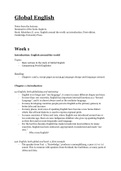Global English
Notes from the lectures.
Summaries of the book chapters.
Book: Scheidner, E. 2011. English around the world: an introduction. First edition.
Cambridge University Press.
Week 1
Introduction: English around the world
Topics:
- Basic notions in the study of Global English
- Categorizing World Englishes
Reading
- Chapters 1 and 2, except pages 25-29 (2.3 Language change and language contact)
Chapter 1: Introduction
1.1 English, both globalizing and nativizing
- English is no longer just “one language”; it comes in many different shapes and sizes.
- In more than 100 countries, English has important internal functions as a “Second
Language”, and it is almost always used as the mediator language.
- In many developing countries people perceive English as the primary gateway to
better jobs and incomes.
- In many places, local ways of speaking English have become a new home dialect
which, like all local dialects, is used to express regional pride.
- In many countries of Africa and Asia, where English was introduced around one or
two centuries ago, there are now indigenous children who grow up speaking English
as their first and/or most frequently used language.
- For the last few decades, English has made inroads into local cultures. In many
countries, English has been embraced, appropriated, transformed and made “our
own.”
- Who owns English?
1.2 English, both global and local: a first example
- The speaker from Text 1, “Knowledge,” produces a monophthong, a pure /e/ or /o/
sound. This is common with speakers from Scotland, the Caribbean, or many parts of
Africa and Asia.
, - The speaker’s accent, like standard British English (BrE) but unlike American English
(AmE), is “non-rhotic,” i.e. he does not pronounce an /r/ after vowels, e.g. in energy
or form.
- This is an indication that the sample may come from the domain of the former
British Empire.
- The final consonant clusters are consistently reduced. This means that whenever at
the end of a word two consonants occur in a row, the second one is not realized at all.
1.3 Chapter previews
- Discusses what will be in the next chapters.
Chapter 2: Basic Notions
2.1 Language variation
- People are taught that there is a “proper English” or “Standard English” which is
correct. However, from the perspective of how language really works, such a mindset
is erroneous.
- People talk differently, depending on who they are and where they come from.
- What counts is only that the speaker and the hearer share knowledge, subconsciously,
on how the message intended was encoded and is to be decoded.
- Linguists emphasize the fact that languages vary, and they do so systematically,
correlating with “sociolinguistic parameters” such as a speaker’s regional origin
or age.
- The neutral term for such group specific language forms is “a variety.”
- Any set of language habits that is shared by a certain group of speakers for use
in certain contexts constitutes such a variety.
- “A dialect,” which also denotes a language form associated with a certain group of
people, is usually associated with a given region (“regional dialect”) or a social class
or group (“social dialect”).
- “A register” refers to stylistically defined language varieties associated with certain
channels (such as spoken or written) or situational contexts (e.g. letter writing,
texting, or giving a political speech).
- “An accent” relates to pronunciation only, but otherwise conforms largely to the
reference of “dialect”
- The above definitions also cover the language forms usually labeled “standard.”
- “Standard British English” describes a certain speech form shared by certain
speakers for use in certain situations.
- As a communicative system, standard English is not inherently superior to or
“better” than any regional dialect. In communication matters it is linguistic
and situational appropriateness that counts, not an inherent notion of
“correctness.
- Dialect differences tend to be finely graded. The overall composition of sets of
variants identifies any particular region.
- The usual criterion to decide if two language systems are dialects of the same
language or different languages is mutual intelligibility
, - Speakers of different dialects of the same language are assumed to understand
each other, speakers of languages don’t, but it’s not that simple. What counts
as understanding?
- Linguists have come to recognize that the distinction between languages and dialects
is essentially a political one.
- . Language forms spoken in different nation states are commonly considered
languages and language forms spoken in one nation are usually labeled
“dialects”.
- A language is not a monolithic entity; in reality, it comes in many shadings, in
varieties and dialects. And such varieties are all linguistic systems which in their
respective contexts are communicatively fully efficient, regular, and “grammatical.”
2.2 Levels of language (variation)
- There are rules in language, but the rules have to be understood as shared habits in a
speech community and as subconscious knowledge on how to encode and decode
information with sound sequences
- There are different ways of saying the same thing, and the choice of any individual
form of expression depends upon a speaker’s background, the context of the
situation, or subtle nuances in the message intended.
- This is “language variation,” and it is widespread and everywhere.
- Linguists usually focus upon smaller, more manageable units.
- They break down “speech behavior” into “features” of a “language variety”
and attempt to work out and explain how these behave and are employed in
their respective contexts.
- These features are ordered into three main “levels of language variation”:
- Sounds (phonetics and phonology)
- Words (the units of lexis, or vocabulary)
- Structures (“patterns” and the “rules”, such as the grammar, or syntax, of a
language variety).
- Speaking means producing sounds with one’s articulatory organs in the oral cavity.
Phonetics describes how the air stream coming from the lungs is modulated and
given its shape by the lips, the teeth, the tongue, the nose, etc.
- All languages use a limited set of sounds which can be identified and which they use
systematically in building their words, the “phonemes,” the units of phonology.
- Phonology investigates language-specific sound systems. Different languages
and language varieties just “have” certain sounds, which do not exist in other
languages and language varieties.
- Some varieties may have fewer or more sounds, a different phoneme
system, from others.
- Spelling does not reflect sound properly.
- The International Phonetic Alphabet (IPA) was developed as a unique transcription
system in which precisely one character signals one sound.
- Complex expressions, such as local phrases and idioms, make up an important part of
the vocabulary, and which is liberally coined or transferred by “calquing,”
word-by-word translations from one language to another.
- Local phraseology is characteristic of many young World Englishes.
, - An important type in this domain are idioms: word groups which only
together have a specific meaning, so knowing the words individually, does not
help at all.
- Language variation is least conspicuous on the level of syntax (or “grammar”), the
way we combine words to form constructions and sentences, though it is there as
well.
- Morphology is the study of the internal make-up of complex words. It is usually
divided into two halves which align themselves with lexis and grammar, respectively:
word formation and inflection.
- Word formation describes how simple items combine to form new and
complex lexical entities.
- Inflection, the use of endings to express grammatical categories, represents
the grammatical side of morphology, and it may be the source of lots of
variability, both subtractive and additive.
- A related field are differences in pragmatics, conventions on how to behave, also
verbally, in specific contexts.
- Conceptualization: different cultures may categorize things differently, and the
meaning of gestures may vary.
2.4 Categorizing World Englishes
- “World Englishes” is the most encompassing label for “Englishes around the
world”, denoting all or any of the varieties spoken around the world.
- The perspective is usually a national one; regional dialects would probably
qualify only indirectly.
- The term goes back to Braj Kachru, a Kashmiri–American scholar who on an
international scale counts as the founding father of the discipline, and his
school, and in many contexts it may imply notions conventionally associated
with this paradigm (like the “Three Circles” model discussed below, and the
special importance of the Outer Circle).
- The label has emerged as the most neutral and most widely used term.
- “New Englishes,” is explicitly restricted to the newly grown second-language
varieties especially of Africa and Asia, like Tanzanian or Indian English.
- Coined by Platt, Weber, and Ho (1984).
- “Postcolonial Englishes,” unites all the varieties which have shared origins in
(mostly) British colonization activities.
- Emphasizing the historical origin and the processes which have resulted from
it.
- It excludes British English but includes American or Australian English, the
“New Englishes,” and English-related creoles.
- Several classification schemes have been proposed to classify these varieties. There
are three models which have received wider currency. The first one categorizes
countries in which English is spoken into three types:
- “English as a Native Language” (ENL), in which the language is spoken and
handed down as the mother tongue of the majority of the population
- “English as a Second Language” (ESL), in which English has been strongly
rooted for historical reasons and assumes important internal functions (often
alongside indigenous languages), e.g. in politics, education, the media, etc.





